survivors
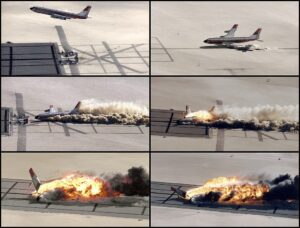 The Controlled Impact Demonstration, also known as “the Crash in the Desert” was a joint project between NASA and the Federal Aviation Administration (FAA). The idea was to intentionally crash a remotely controlled Boeing 720 airplane in order to acquire data and test new technologies to aid passenger and crew survival. As we all know, airplane crashes, often bring fatalities. Still, there have been a number of airplane crashes in which all or most of the plane’s occupants survived the crash. The point of “the crash in the desert” was to learn from the vent, and hopefully make a way for more people to survive the crash.
The Controlled Impact Demonstration, also known as “the Crash in the Desert” was a joint project between NASA and the Federal Aviation Administration (FAA). The idea was to intentionally crash a remotely controlled Boeing 720 airplane in order to acquire data and test new technologies to aid passenger and crew survival. As we all know, airplane crashes, often bring fatalities. Still, there have been a number of airplane crashes in which all or most of the plane’s occupants survived the crash. The point of “the crash in the desert” was to learn from the vent, and hopefully make a way for more people to survive the crash.
The Controlled Impact Demonstration took more than four years of preparation by NASA Ames Research Center, Langley Research Center, Dryden Flight Research Center, the FAA, and General Electric to pull off. Then, because obviously they did not have an unlimited supply of planes, they held several test runs to make sure they had the right “crash” conditions to learn the most about crashes. Finally, on December 1, 1984, the plane was actually crashed. The test went pretty much according to plan and produced a large fireball that required more than an hour to extinguish. With that in mind, a casual observer would assume that everyone would have died, but the FAA concluded that about one-quarter of the passengers would have survived!! It also determined that the antimisting kerosene test fuel did not sufficiently reduce the risk of fire. Antimisting kerosene (AMK) is “a jet fuel containing an antimisting additive. This additive, a high-molecular-weight polymer, causes the fuel to resist atomization and liquid shear forces, which also affect flow characteristics in the engine fuel system.” Finally, it determined that several changes to equipment in the passenger compartment of aircraft were needed…which is probably one of the most important findings of the demonstration. NASA also concluded that a head-up display and microwave landing system would have definitely helped the pilot more safely fly the aircraft.
On the morning of December 1, 1984, the test aircraft took off from Edwards Air Force Base, California. Once aloft, the plane made a left-hand departure and climbed to an altitude of 2,300 feet. The plane was remotely flown by NASA research pilot Fitzhugh Fulton from the NASA Dryden Remotely Controlled Vehicle Facility. All fuel tanks were filled with a total of 76,000 pounds of AMK and all engines ran from start-up to impact. The total flight time was 9 minutes on the modified Jet-A. It then began a descent-to-landing along the roughly 3.8-degree glideslope to a specially prepared runway on the east side of Rogers Dry Lake, with the landing gear remaining retracted.
Passing the decision height of 150 feet above ground level (AGL), the airplane turned slightly to the right of the desired path, entering into a situation known as a Dutch roll. Slightly above that decision point at which the 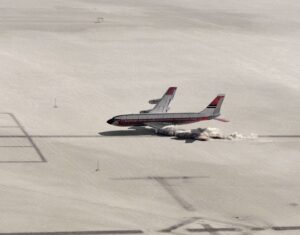 pilot was to execute a “go-around” maneuver. There appeared to be enough altitude to maneuver back to the center-line of the runway. The aircraft was below the glideslope and below the desired airspeed. At this point, the data acquisition systems had been activated, and the plane was committed to impact. That situation had to have almost a strange feeling to it…that point of knowing that the plane was going to crash and knowing that the crash was exactly what you wanted it to do. Then the plane contacted the ground, left wing low, at full throttle, with its nose pointing to the left of the center-line. The original plan was that “the aircraft would land wings-level, with the throttles set to idle, and exactly on the center-line during the CID, thus allowing the fuselage to remain intact as the wings were sliced open by eight posts cemented into the runway (called “Rhinos” due to the shape of the “horns” welded onto the posts).” The Boeing 720 had a surprise in store for the researchers, when it landed askew. “One of the Rhinos sliced through the number 3 engine, behind the burner can, leaving the engine on the wing pylon, which does not typically happen in an impact of this type. The same rhino then sliced through the fuselage, causing a cabin fire when burning fuel was able to enter the fuselage.”
pilot was to execute a “go-around” maneuver. There appeared to be enough altitude to maneuver back to the center-line of the runway. The aircraft was below the glideslope and below the desired airspeed. At this point, the data acquisition systems had been activated, and the plane was committed to impact. That situation had to have almost a strange feeling to it…that point of knowing that the plane was going to crash and knowing that the crash was exactly what you wanted it to do. Then the plane contacted the ground, left wing low, at full throttle, with its nose pointing to the left of the center-line. The original plan was that “the aircraft would land wings-level, with the throttles set to idle, and exactly on the center-line during the CID, thus allowing the fuselage to remain intact as the wings were sliced open by eight posts cemented into the runway (called “Rhinos” due to the shape of the “horns” welded onto the posts).” The Boeing 720 had a surprise in store for the researchers, when it landed askew. “One of the Rhinos sliced through the number 3 engine, behind the burner can, leaving the engine on the wing pylon, which does not typically happen in an impact of this type. The same rhino then sliced through the fuselage, causing a cabin fire when burning fuel was able to enter the fuselage.”
“The cutting of the number 3 engine and the full-throttle situation was significant, as this was outside the test envelope. The number 3 engine continued to operate for approximately 1/3 of a rotation, degrading the fuel and igniting it after impact, providing a significant heat source. The fire and smoke took over an hour to extinguish. The CID impact was spectacular with a large fireball created by the number 3 engine on the right side, enveloping and burning the aircraft. From the standpoint of AMK the test was a major set-back. For NASA Langley, the data collected on crashworthiness was deemed successful and just as important.”
The actual impact proved that the antimisting additive they had tested was not going to prevent a post-crash fire in all situations, but the reduced intensity of the initial fire was attributed to the effect of the AMK. FAA investigators estimated that 23% to 25% of the aircraft’s full capacity of 113 people could have survived the crash. Now that is saying something, considering the way the crash looked to observers. “Time from slide-out to complete smoke obscuration for the forward cabin was 5 seconds; for the aft cabin, it was 20 seconds. Total time to evacuate was 15 and 33 seconds respectively, accounting for the time necessary to reach and open the doors and operate the slide.” The FAA instituted new flammability standards for seat cushions which required the use of fire-blocking layers as a result of analysis of the crash, resulting in seats which performed better than those in the test. From this crash demonstration, came the implementation of a standard requiring floor 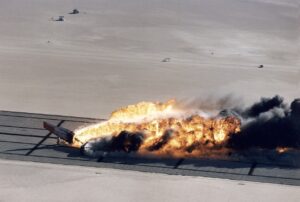 proximity lighting to be mechanically fastened, due to the apparent detachment of two types of adhesive-fastened emergency lights during the impact. In addition, federal aviation regulations for flight data recorder sampling rates for pitch, roll, and acceleration were found to be insufficient. NASA determined that at the point of impact, the piloting task workload unusually high, which might have been reduced through the use of a heads-up display, the automation of more tasks, and a higher-resolution monitor. The use of a microwave landing system to improve tracking accuracy over the standard instrument landing system was also recommended. The Global Positioning System-based Wide Area Augmentation System came to fulfill this role.
proximity lighting to be mechanically fastened, due to the apparent detachment of two types of adhesive-fastened emergency lights during the impact. In addition, federal aviation regulations for flight data recorder sampling rates for pitch, roll, and acceleration were found to be insufficient. NASA determined that at the point of impact, the piloting task workload unusually high, which might have been reduced through the use of a heads-up display, the automation of more tasks, and a higher-resolution monitor. The use of a microwave landing system to improve tracking accuracy over the standard instrument landing system was also recommended. The Global Positioning System-based Wide Area Augmentation System came to fulfill this role.

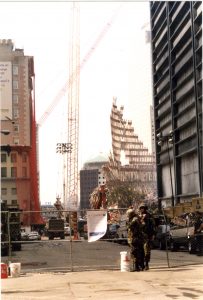 May 30, 2002 dawned, a typically warm New York City day, but this was not a typical day at all. It had been a long, emotionally grueling 8 months and 19 days of cleanup after the September 11, 2001 attacks on the World Trade Center, the Pentagon, and the crash site in Shanksville, Pennsylvania. The majority of the lost were in the World Trade Center in New York City. Those 8 months and 19 days were filled with every possible emotion there could be…from joy when one was found alive, to grief over the lost, to anger at the attack, to hate for the Muslim attackers, to love for the survivors and the families of the lost. It was something that we all knew that we could never really wrap our heads around, and something that we knew we would never forget. It was a senseless attack that proved only that the attackers were insane and filled with hate for Americans and Christians. It was a time when America came together as one, and donated time, money, letters, and love to each other, because we were all victims of this attack, after all.
May 30, 2002 dawned, a typically warm New York City day, but this was not a typical day at all. It had been a long, emotionally grueling 8 months and 19 days of cleanup after the September 11, 2001 attacks on the World Trade Center, the Pentagon, and the crash site in Shanksville, Pennsylvania. The majority of the lost were in the World Trade Center in New York City. Those 8 months and 19 days were filled with every possible emotion there could be…from joy when one was found alive, to grief over the lost, to anger at the attack, to hate for the Muslim attackers, to love for the survivors and the families of the lost. It was something that we all knew that we could never really wrap our heads around, and something that we knew we would never forget. It was a senseless attack that proved only that the attackers were insane and filled with hate for Americans and Christians. It was a time when America came together as one, and donated time, money, letters, and love to each other, because we were all victims of this attack, after all.
On May 29, 2002, the last beam was removed from the site…marking the end of the cleanup effort that had been expected to last a year. There were many disappointments in the cleanup, because there were very few people pulled out alive after that first day, and in fact, the last survivor was pulled out 27 hours after the attack. There would be no more lives saved. People were lined up to donate blood in the hope that someone’s life could be saved, but the sad reality was that very few whole bodies were even pulled from the rubble. Most were bits and pieces, body parts, and even just fragments of bone or teeth. Authorities put the final death toll from the World Trade Center’s destruction at 2,823. Of those 2823 people, only 1,102 victims have been identified, and only 289 intact bodies were recovered.
The ceremony…if it could really be called that, because ceremony usually means a happy event…began in silence. There would be no speeches. Thousands of people stood silently in one place…Ground Zero, and no one spoke…no one spoke!! The ceremony began with the sound of a fire bell ringing for the fallen firefighters at 10:29 am ET, the same time the World Trade Center’s north tower collapsed on September 11, 2001. Thousands of people stood in silence, some with tears streaming from their eyes, as an honor guard made up of police, firefighters, and representatives of other agencies walked slowly up a ramp from the site carrying a stretcher bearing only an American flag. The flag, symbolizing the victims who were killed on September 11, but never found, was placed into a waiting ambulance. It was followed by a flatbed truck carrying the last 50 ton steel column from the site of the Trade Center ruins. The beam was part of the southeast corner of the south tower. It was hoisted onto a flatbed truck and shrouded in black cloth after its removal on May 29, 2002. Ten minutes into the ceremony, a pair of buglers…one from New York’s Police Department, the other from the New York Fire Department…played “Taps,” followed by a flyover of NYPD helicopters. Among the dead following the horrific attack, were 343 New York firefighters and an estimated 70 police officers from various departments, including 37 from New York’s Port Authority and 23 from the New York Police Department. Fewer than half of the firefighters who died were recovered. Five of them were from the Chelsea Firehouse, Engine 3 and Ladder 12. At the fire stations and police stations in New York City, dozens of family and friends watched the tribute on television. Hundreds of workers had labored around the clock since September 11 to recover the 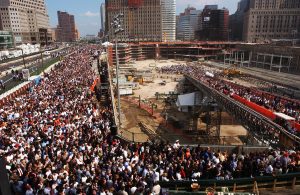
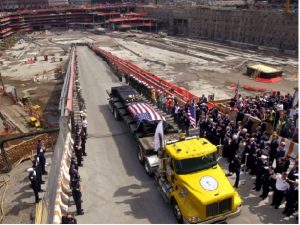 bodies of those who died in the attack and to remove the 1.6 million tons of steel and concrete left behind. The debris was moved to a Staten Island landfill, but reminders of the attack remain in the area. “It’s over, but it will never be forgotten,” said FDNY Battalion Commander Richard Picciotto, who was in the north tower when it was hit. He was right. Today marks the 15th anniversary of that ceremony, and we have not forgotten.
bodies of those who died in the attack and to remove the 1.6 million tons of steel and concrete left behind. The debris was moved to a Staten Island landfill, but reminders of the attack remain in the area. “It’s over, but it will never be forgotten,” said FDNY Battalion Commander Richard Picciotto, who was in the north tower when it was hit. He was right. Today marks the 15th anniversary of that ceremony, and we have not forgotten.
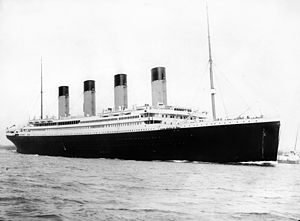 On this, the 105 anniversary of the April 10, 1912 sailing of the RMS Titanic, for her maiden and only voyage, my thoughts have been leaning toward the people who were on board, and particularly those who did not survive that fateful trip. The Titanic was the most amazing ship of it’s time, filled with luxuries beyond the imagination…at least in first class. Back then, people were separated into classes based on their social importance. It’s sad to think about that, because every person has value, and many of those in 3rd class, or steerage were considered expendable. Nevertheless, it was not just those in steerage who lost their lives when Titanic went down on April 12th, 1912.
On this, the 105 anniversary of the April 10, 1912 sailing of the RMS Titanic, for her maiden and only voyage, my thoughts have been leaning toward the people who were on board, and particularly those who did not survive that fateful trip. The Titanic was the most amazing ship of it’s time, filled with luxuries beyond the imagination…at least in first class. Back then, people were separated into classes based on their social importance. It’s sad to think about that, because every person has value, and many of those in 3rd class, or steerage were considered expendable. Nevertheless, it was not just those in steerage who lost their lives when Titanic went down on April 12th, 1912.
As Titanic set sail on April 10th, here was much excitement. Those who were “lucky” enough to have secured passage, were to be envied. Of course, the rich and famous had no trouble paying for their passage, but the less fortunate had a different situation, and different accommodations. Many of the steerage passengers had spent their last penny to pay for their passage, and still they considered it money well spent, because they were heading to America for a better life. Little did any of the passengers in all three classes know that in just two days, their beautiful ship would be at the bottom of the ocean, along with many of her passengers and crew. It is here that I began to wonder what they were thinking as the ship sank beneath their feet, into the deep dark  murky depths. I know most of them were just trying to find a way to get onto one of the life boats…of which there were too few by at least half, but did it also become that moment when they thought about what might have been for them…had they not taken this particular trip, on this particular ship. I think that anytime a person finds themselves faced with death, their thoughts turn to family, friends, and what might have been. Most luxury trips taken are for a few reasons…among them the scenery, a long awaited visit, or just the sheer luxury of this particular type of trip. No one really considers what might happen if things go wrong, or at the very least, we try not to think about it. Still, when the moment of emergency arrives, did the passengers of Titanic think that if only they had waited for Titanic’s next trip, they wouldn’t be here today…in this most horrible of situations, with so many others screaming in fear, because they knew they were about to die…unless a miracle happened for them.
murky depths. I know most of them were just trying to find a way to get onto one of the life boats…of which there were too few by at least half, but did it also become that moment when they thought about what might have been for them…had they not taken this particular trip, on this particular ship. I think that anytime a person finds themselves faced with death, their thoughts turn to family, friends, and what might have been. Most luxury trips taken are for a few reasons…among them the scenery, a long awaited visit, or just the sheer luxury of this particular type of trip. No one really considers what might happen if things go wrong, or at the very least, we try not to think about it. Still, when the moment of emergency arrives, did the passengers of Titanic think that if only they had waited for Titanic’s next trip, they wouldn’t be here today…in this most horrible of situations, with so many others screaming in fear, because they knew they were about to die…unless a miracle happened for them.
Titanic was carrying 2,222 people (passengers and crew), when she set sail. Of those people only 706 would receive that miracle. For the rest, this would be the end of their life. Of the 706 survivors, 492 were passengers, and 214 were crew members, a fact that I find rather odd. The class distinctions were closer to expected, with 61% of first class passengers surviving, 42% of second class passengers surviving, and 24% of third class passengers surviving. That is a sad reality of a time when class was everything. I’m sure that all of 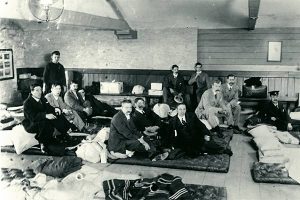 these people felt that their lives were a tremendous gift, and I’m sure too that their lives changed in a big way. Still, I wonder about the final thoughts of the 1516 people who died that day. I’m sure they wished they had not taken the trip, and I’m sure that they regretted the fact that their family would be sad. It really doesn’t matter what they were thinking, I guess, because it was too late to change what was…for most of them anyway. For the holder of Ticket number 242154, it appears that it was not to late. The holder of that ticket is unknown, but they were given a full refund for their ticket, and it appears that they did not sail on Titanic. Perhaps, they had their ear to the Lord’s Word, and were told not to sail. Not knowing who this person was, we will never know for sure.
these people felt that their lives were a tremendous gift, and I’m sure too that their lives changed in a big way. Still, I wonder about the final thoughts of the 1516 people who died that day. I’m sure they wished they had not taken the trip, and I’m sure that they regretted the fact that their family would be sad. It really doesn’t matter what they were thinking, I guess, because it was too late to change what was…for most of them anyway. For the holder of Ticket number 242154, it appears that it was not to late. The holder of that ticket is unknown, but they were given a full refund for their ticket, and it appears that they did not sail on Titanic. Perhaps, they had their ear to the Lord’s Word, and were told not to sail. Not knowing who this person was, we will never know for sure.

